display TOYOTA RAV4 PLUG-IN HYBRID 2023 User Guide
[x] Cancel search | Manufacturer: TOYOTA, Model Year: 2023, Model line: RAV4 PLUG-IN HYBRID, Model: TOYOTA RAV4 PLUG-IN HYBRID 2023Pages: 718, PDF Size: 167.55 MB
Page 83 of 718
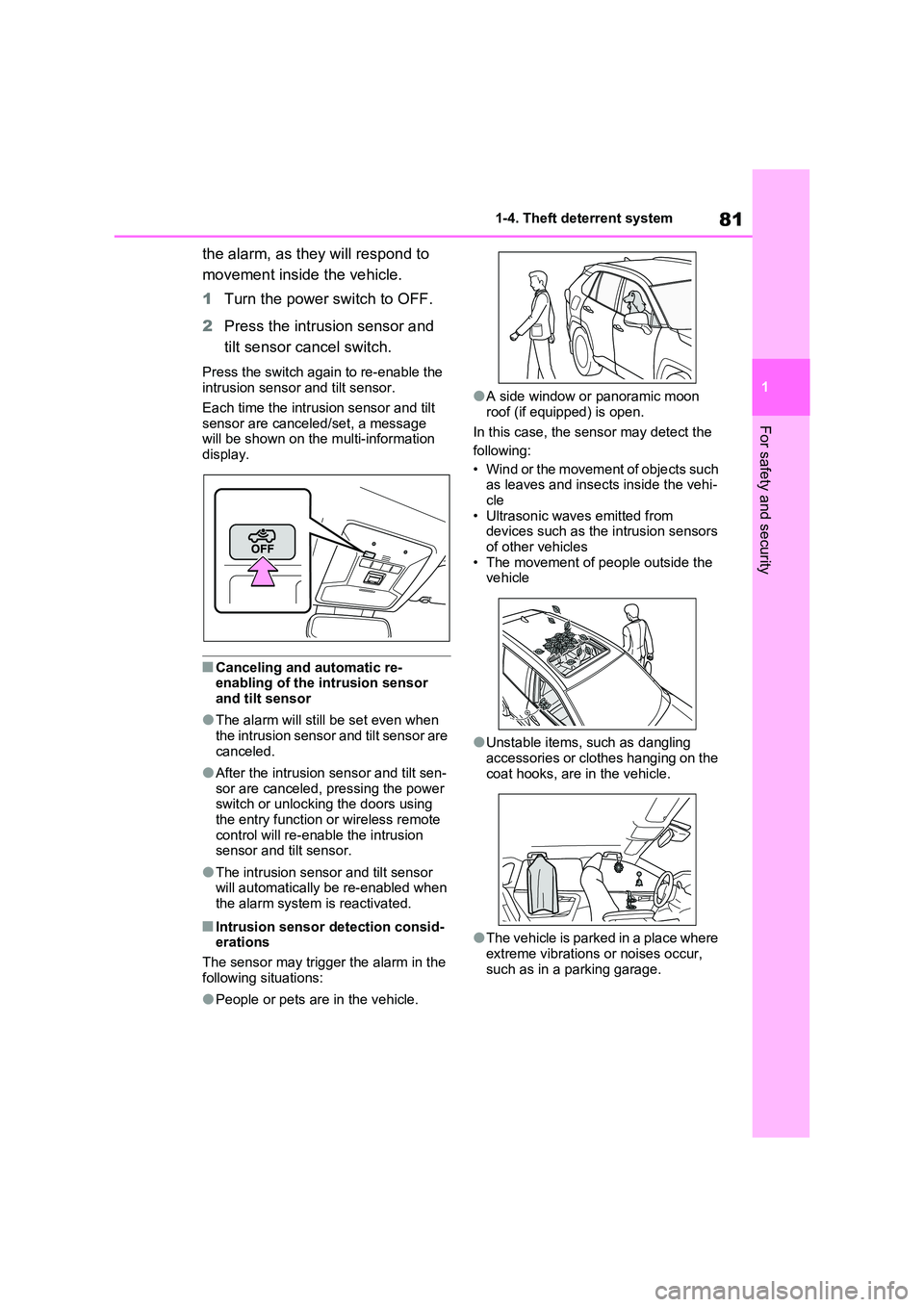
81
1
1-4. Theft deterrent system
For safety and security
the alarm, as they will respond to
movement inside the vehicle.
1 Turn the power switch to OFF.
2 Press the intrusion sensor and
tilt sensor cancel switch.
Press the switch again to re-enable the intrusion sensor and tilt sensor.
Each time the intrusion sensor and tilt
sensor are canceled/set, a message will be shown on the multi-information display.
■Canceling and automatic re-enabling of the intrusion sensor
and tilt sensor
●The alarm will still be set even when
the intrusion sensor and tilt sensor are canceled.
●After the intrusion sensor and tilt sen-sor are canceled, pressing the power switch or unlocking the doors using
the entry function or wireless remote control will re-enable the intrusion sensor and tilt sensor.
●The intrusion sensor and tilt sensor will automatically be re-enabled when
the alarm system is reactivated.
■Intrusion sensor detection consid- erations
The sensor may trigger the alarm in the
following situations:
●People or pets are in the vehicle.
●A side window or panoramic moon
roof (if equipped) is open.
In this case, the sensor may detect the
following:
• Wind or the movement of objects such as leaves and insects inside the vehi-
cle • Ultrasonic waves emitted from devices such as the intrusion sensors
of other vehicles • The movement of people outside the vehicle
●Unstable items, such as dangling accessories or clothes hanging on the
coat hooks, are in the vehicle.
●The vehicle is parked in a place where
extreme vibrations or noises occur, such as in a parking garage.
Page 87 of 718
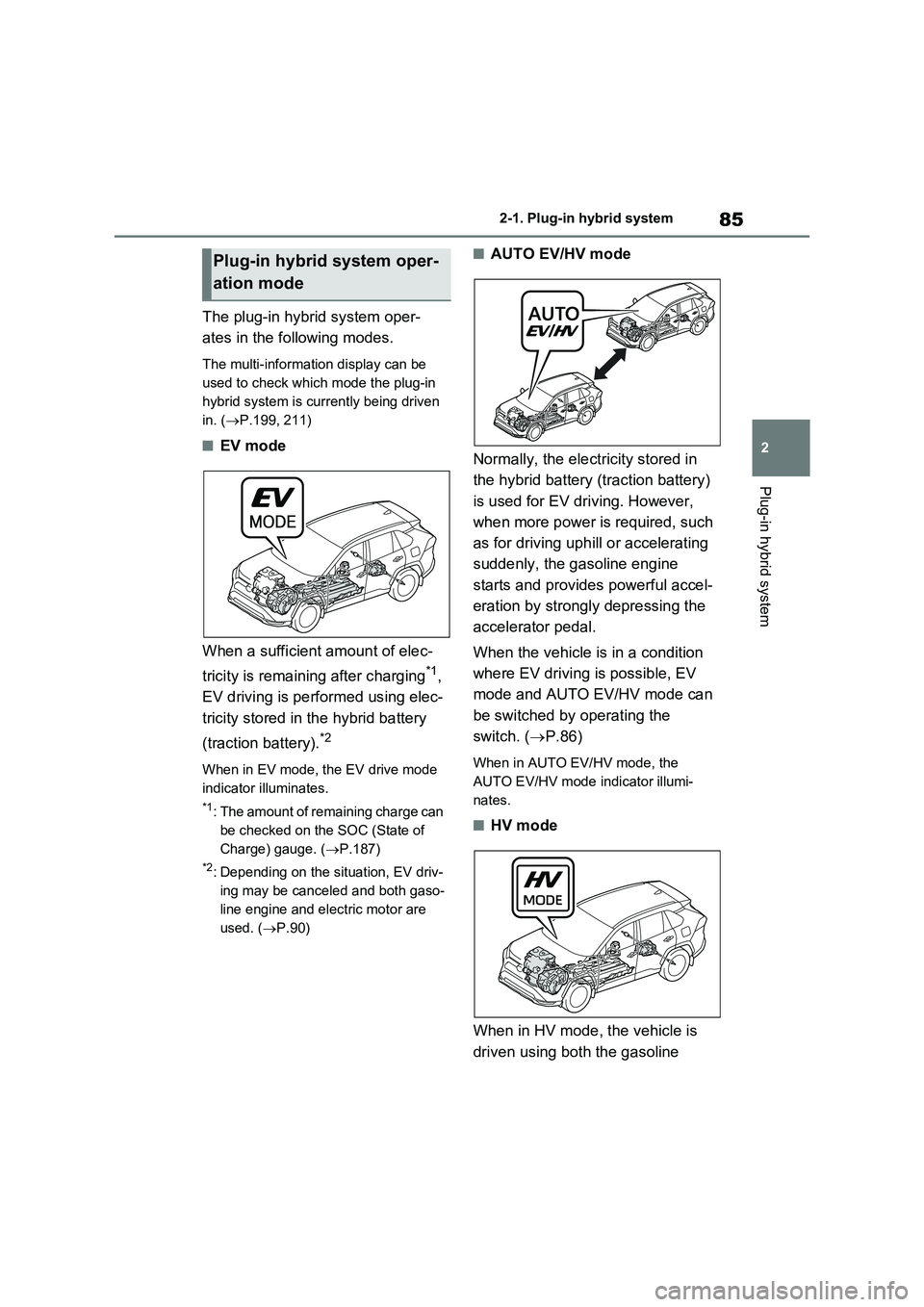
85
2
2-1. Plug-in hybrid system
Plug-in hybrid system
The plug-in hybrid system oper-
ates in the following modes.
The multi-information display can be
used to check which mode the plug-in
hybrid system is currently being driven
in. ( P.199, 211)
■EV mode
When a sufficient amount of elec-
tricity is remaining after charging*1,
EV driving is performed using elec-
tricity stored in the hybrid battery
(traction battery).*2
When in EV mode, the EV drive mode
indicator illuminates.
*1: The amount of remaining charge can
be checked on the SOC (State of
Charge) gauge. ( P.187)
*2: Depending on the situation, EV driv-
ing may be canceled and both gaso-
line engine and electric motor are
used. ( P.90)
■AUTO EV/HV mode
Normally, the electricity stored in
the hybrid battery (traction battery)
is used for EV driving. However,
when more power is required, such
as for driving uphill or accelerating
suddenly, the gasoline engine
starts and provides powerful accel-
eration by strongly depressing the
accelerator pedal.
When the vehicle is in a condition
where EV driving is possible, EV
mode and AUTO EV/HV mode can
be switched by operating the
switch. ( P.86)
When in AUTO EV/HV mode, the
AUTO EV/HV mode indicator illumi-
nates.
■HV mode
When in HV mode, the vehicle is
driven using both the gasoline
Plug-in hybrid system oper-
ation mode
Page 90 of 718
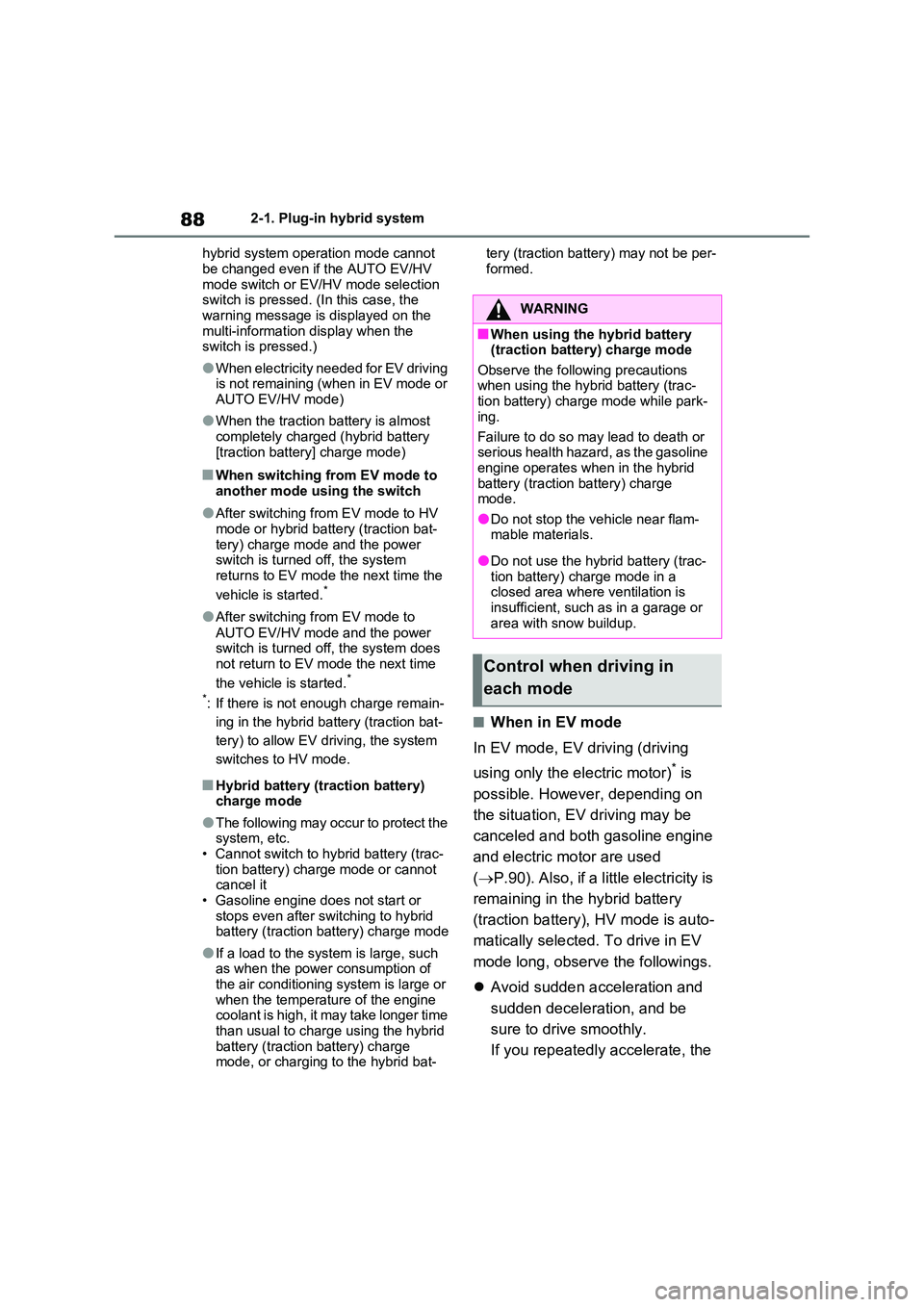
882-1. Plug-in hybrid system
hybrid system operation mode cannot
be changed even if the AUTO EV/HV mode switch or EV/HV mode selection switch is pressed. (In this case, the
warning message is displayed on the multi-information display when the switch is pressed.)
●When electricity needed for EV driving is not remaining (when in EV mode or
AUTO EV/HV mode)
●When the traction battery is almost
completely charged (hybrid battery [traction battery] charge mode)
■When switching from EV mode to another mode using the switch
●After switching from EV mode to HV
mode or hybrid battery (traction bat-
tery) charge mode and the power switch is turned off, the system returns to EV mode the next time the
vehicle is started.*
●After switching from EV mode to
AUTO EV/HV mode and the power switch is turned off, the system does
not return to EV mode the next time
the vehicle is started.*
*: If there is not enough charge remain-
ing in the hybrid battery (traction bat-
tery) to allow EV driving, the system
switches to HV mode.
■Hybrid battery (traction battery) charge mode
●The following may occur to protect the system, etc.
• Cannot switch to hybrid battery (trac- tion battery) charge mode or cannot cancel it
• Gasoline engine does not start or stops even after switching to hybrid battery (traction battery) charge mode
●If a load to the system is large, such as when the power consumption of
the air conditioning system is large or when the temperature of the engine coolant is high, it may take longer time
than usual to charge using the hybrid battery (traction battery) charge mode, or charging to the hybrid bat-
tery (traction battery) may not be per-
formed.
■When in EV mode
In EV mode, EV driving (driving
using only the electric motor)* is
possible. However, depending on
the situation, EV driving may be
canceled and both gasoline engine
and electric motor are used
( P.90). Also, if a little electricity is
remaining in the hybrid battery
(traction battery), HV mode is auto-
matically selected. To drive in EV
mode long, observe the followings.
Avoid sudden acceleration and
sudden deceleration, and be
sure to drive smoothly.
If you repeatedly accelerate, the
WARNING
■When using the hybrid battery (traction battery) charge mode
Observe the following precautions when using the hybrid battery (trac-tion battery) charge mode while park-
ing.
Failure to do so may lead to death or serious health hazard, as the gasoline
engine operates when in the hybrid battery (traction battery) charge mode.
●Do not stop the vehicle near flam-mable materials.
●Do not use the hybrid battery (trac-tion battery) charge mode in a closed area where ventilation is
insufficient, such as in a garage or area with snow buildup.
Control when driving in
each mode
Page 91 of 718
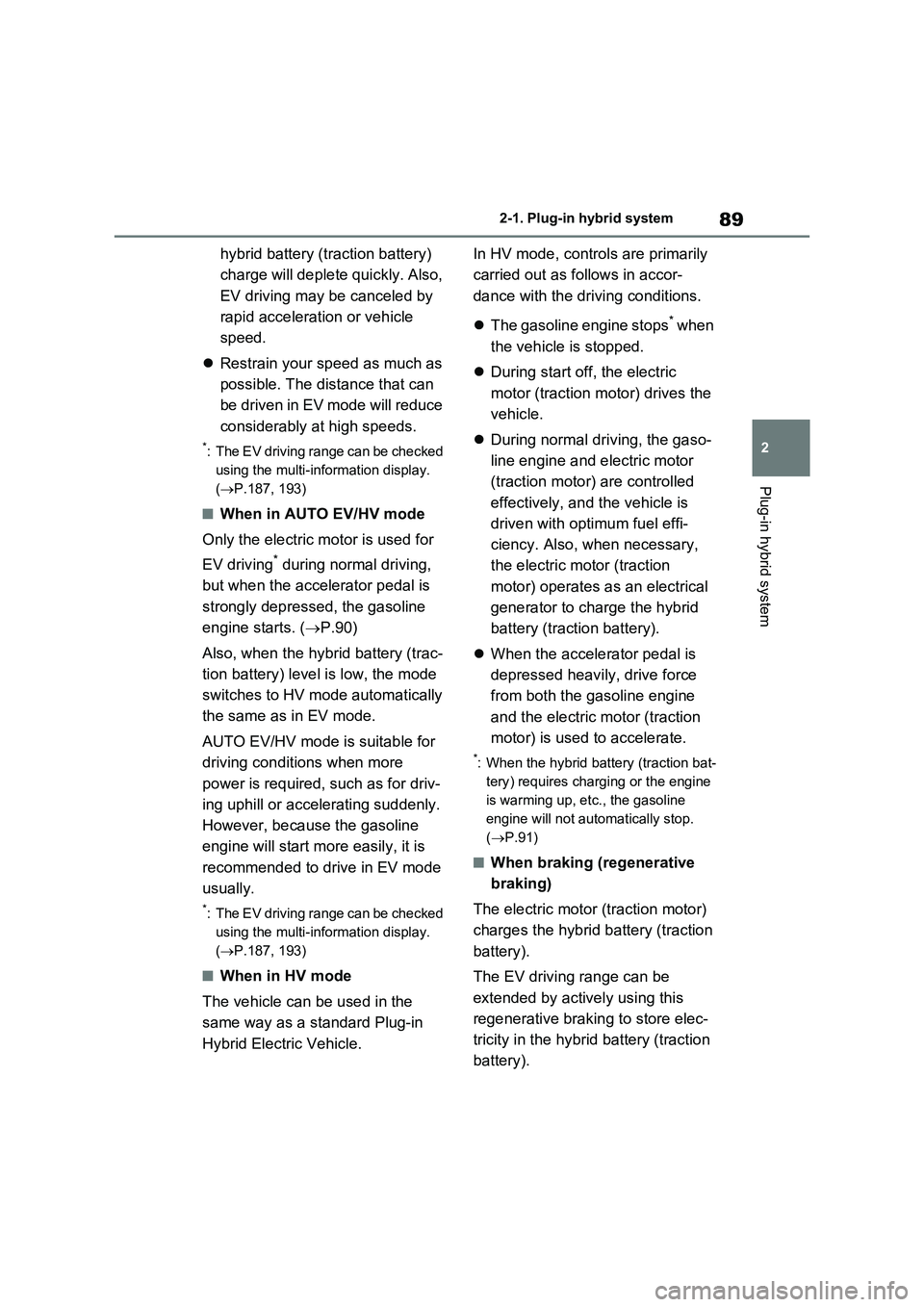
89
2 2-1. Plug-in hybrid system
Plug-in hybrid system
hybrid battery (traction battery)
charge will deplete quickly. Also,
EV driving may be canceled by
rapid acceleration or vehicle
speed.
Restrain your speed as much as
possible. The distance that can
be driven in EV mode will reduce
considerably at high speeds.
*: The EV driving range can be checked
using the multi-information display.
(P.187, 193)
■When in AUTO EV/HV mode
Only the electric motor is used for
EV driving
* during normal driving,
but when the accelerator pedal is
strongly depressed, the gasoline
engine starts. (P.90)
Also, when the hybrid battery (trac-
tion battery) level is low, the mode
switches to HV mode automatically
the same as in EV mode.
AUTO EV/HV mode is suitable for
driving conditions when more
power is required, such as for driv-
ing uphill or accelerating suddenly.
However, because the gasoline
engine will start more easily, it is
recommended to drive in EV mode
usually.
*: The EV driving range can be checked
using the multi-information display.
(P.187, 193)
■When in HV mode
The vehicle can be used in the
same way as a standard Plug-in
Hybrid Electric Vehicle.In HV mode, controls are primarily
carried out as follows in accor-
dance with the driving conditions.
The gasoline engine stops
* when
the vehicle is stopped.
During start off, the electric
motor (traction motor) drives the
vehicle.
During normal driving, the gaso-
line engine and electric motor
(traction motor) are controlled
effectively, and the vehicle is
driven with optimum fuel effi-
ciency. Also, when necessary,
the electric motor (traction
motor) operates as an electrical
generator to charge the hybrid
battery (traction battery).
When the accelerator pedal is
depressed heavily, drive force
from both the gasoline engine
and the electric motor (traction
motor) is used to accelerate.
*: When the hybrid battery (traction bat-
tery) requires charging or the engine
is warming up, etc., the gasoline
engine will not automatically stop.
(P.91)
■When braking (regenerative
braking)
The electric motor (traction motor)
charges the hybrid battery (traction
battery).
The EV driving range can be
extended by actively using this
regenerative braking to store elec-
tricity in the hybrid battery (traction
battery).
Page 92 of 718

902-1. Plug-in hybrid system
Moreover, as fuel consumption is
also reduced when in HV mode, the
regenerative braking system can be
used effectively.
■Regenerative braking
In the following situations, kinetic energy
is converted to electric energy and
deceleration force can be obtained in
conjunction with the recharging of the
hybrid battery (traction battery).
●The accelerator pedal is released
while driving with the shift lever in D or
S.
●The brake pedal is depressed while
driving with the shift lever in D or S.
■EV driving range
●The EV driving range is displayed on
the multi-information display.
(P.187, 193)
●The EV driving range changes in
accordance with the charge status of
the hybrid battery (traction battery),
the speed of the vehicle, etc.
●Even if there is enough charge
remaining in the hybrid battery (trac-
tion battery), EV driving may be can-
celed and both gasoline engine and
electric motor are used depending on
the situation. (P.90)
■EV indicator
The EV indicator comes on when the
vehicle is driven using only the electric
motor (traction motor) or the gasoline
engine is stopped.
The on/off operation of the EV indicator
can be changed. (P.206, 217)
■After EV mode has switched to HV
mode due to low hybrid battery
(traction battery) charge
If the hybrid battery (traction battery) is
regenerated by driving continuously
down a long slope, the EV driving range
etc. will be displayed on the multi-infor-
mation display and EV mode will be
automatically switched to.
If EV mode is not switched to even
though EV driving range is being dis-
played, EV mode can be switched to by
pressing the EV/HV mode selection
switch.
■Gasoline engine operation in EV
mode or AUTO EV/HV mode
Even if there is a sufficient amount of
electricity remaining in the hybrid battery
(traction battery) and EV driving range
(P.201, 213) is being displayed on the
multi-information display, EV driving
(driving using only the electric motor)
may be canceled and both gasoline
engine and electric motor are used
depending on the situation (EV driving
will be returned to automatically after EV
driving becomes possible again).
EV driving may be canceled automati-
cally in the following circumstances
*1:
●When vehicle speed is more than
approximately 135 km/h (84 mph).
●When power is needed temporarily,
for example when the accelerator
pedal is depressed firmly or when
accelerating suddenly.
*2
●When the temperature of the hybrid
system is high.
The vehicle has been left in the sun,
driven on a hill, driven at high speeds,
etc.
●When the temperature of the hybrid
system is low.
●When the heater is switched on when
the outside temperature is below
about -10°C (14°F).
●When the windshield defogger switch
is pressed. (P.431)
●When the system determines that the
Page 93 of 718
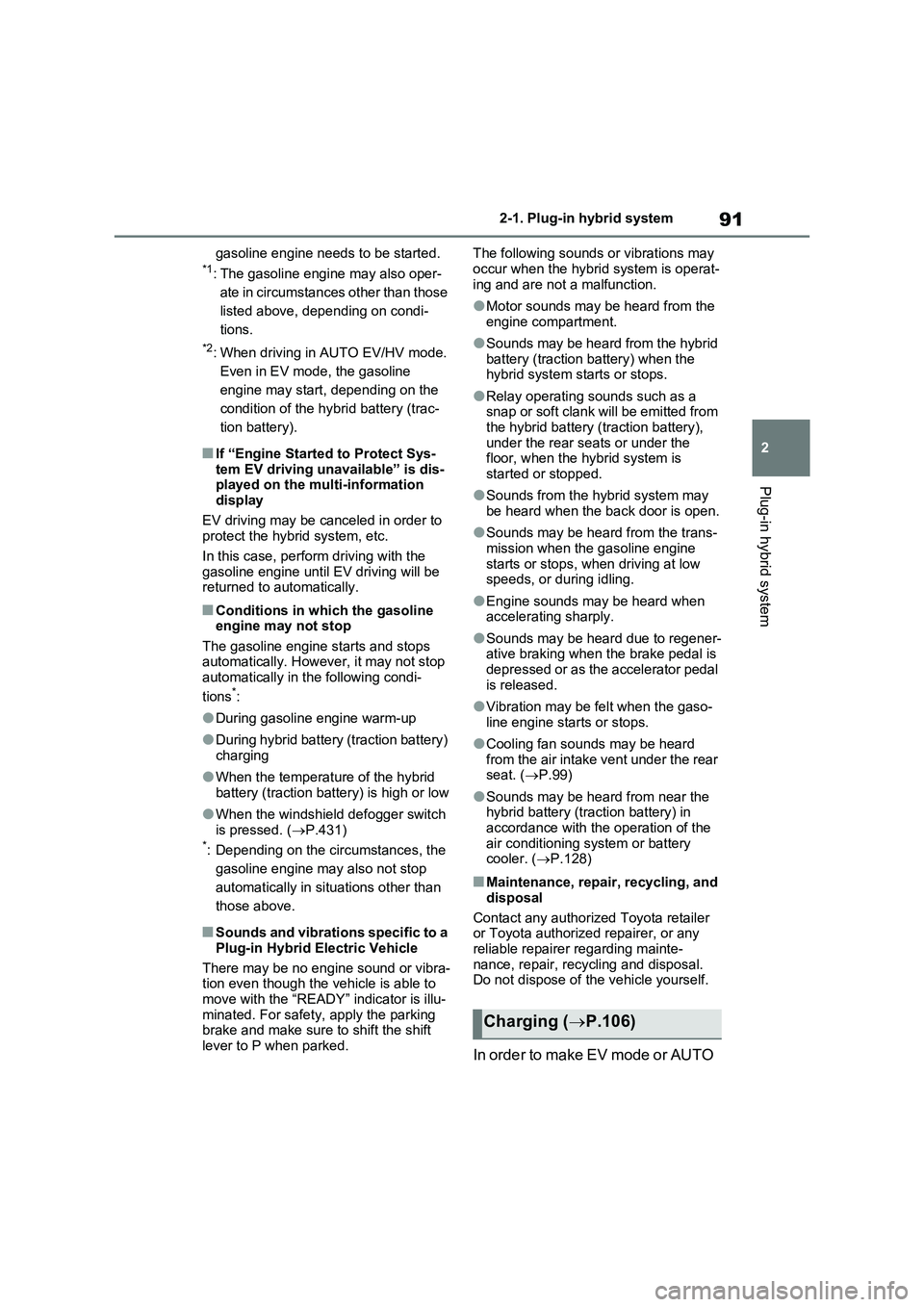
91
2 2-1. Plug-in hybrid system
Plug-in hybrid system
gasoline engine needs to be started.*1: The gasoline engine may also oper-
ate in circumstances other than those
listed above, depending on condi-
tions.
*2: When driving in AUTO EV/HV mode.
Even in EV mode, the gasoline
engine may start, depending on the
condition of the hybrid battery (trac-
tion battery).
■If “Engine Started to Protect Sys-
tem EV driving unavailable” is dis-
played on the multi-information
display
EV driving may be canceled in order to
protect the hybrid system, etc.
In this case, perform driving with the
gasoline engine until EV driving will be
returned to automatically.
■Conditions in which the gasoline
engine may not stop
The gasoline engine starts and stops
automatically. However, it may not stop
automatically in the following condi-
tions
*:
●During gasoline engine warm-up
●During hybrid battery (traction battery)
charging
●When the temperature of the hybrid
battery (traction battery) is high or low
●When the windshield defogger switch
is pressed. (P.431)
*: Depending on the circumstances, the
gasoline engine may also not stop
automatically in situations other than
those above.
■Sounds and vibrations specific to a
Plug-in Hybrid Electric Vehicle
There may be no engine sound or vibra-
tion even though the vehicle is able to
move with the “READY” indicator is illu-
minated. For safety, apply the parking
brake and make sure to shift the shift
lever to P when parked.The following sounds or vibrations may
occur when the hybrid system is operat-
ing and are not a malfunction.
●Motor sounds may be heard from the
engine compartment.
●Sounds may be heard from the hybrid
battery (traction battery) when the
hybrid system starts or stops.
●Relay operating sounds such as a
snap or soft clank will be emitted from
the hybrid battery (traction battery),
under the rear seats or under the
floor, when the hybrid system is
started or stopped.
●Sounds from the hybrid system may
be heard when the back door is open.
●Sounds may be heard from the trans-
mission when the gasoline engine
starts or stops, when driving at low
speeds, or during idling.
●Engine sounds may be heard when
accelerating sharply.
●Sounds may be heard due to regener-
ative braking when the brake pedal is
depressed or as the accelerator pedal
is released.
●Vibration may be felt when the gaso-
line engine starts or stops.
●Cooling fan sounds may be heard
from the air intake vent under the rear
seat. (P.99)
●Sounds may be heard from near the
hybrid battery (traction battery) in
accordance with the operation of the
air conditioning system or battery
cooler. (P.128)
■Maintenance, repair, recycling, and
disposal
Contact any authorized Toyota retailer
or Toyota authorized repairer, or any
reliable repairer regarding mainte-
nance, repair, recycling and disposal.
Do not dispose of the vehicle yourself.
In order to make EV mode or AUTO
Charging (P.106)
Page 95 of 718
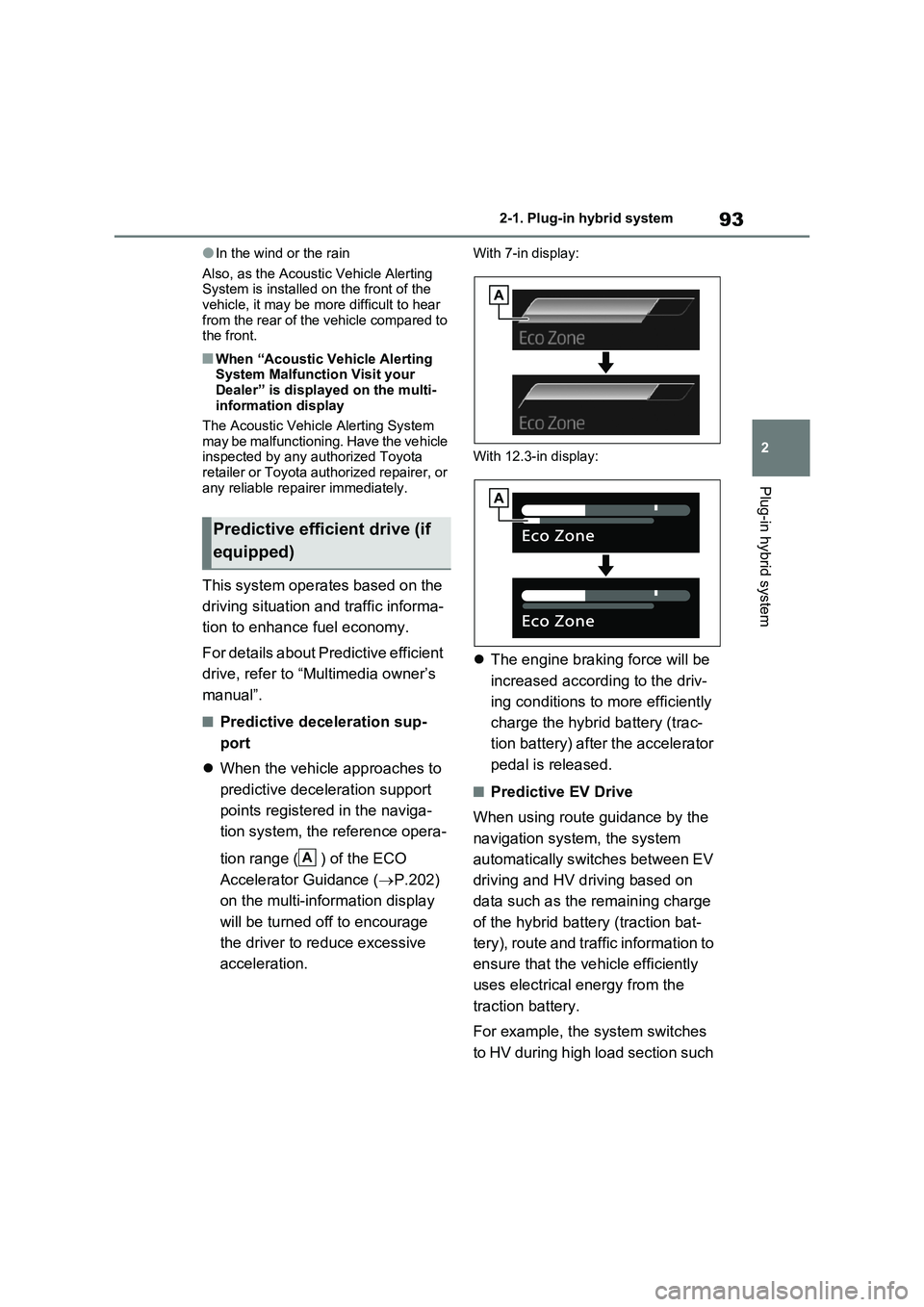
93
2
2-1. Plug-in hybrid system
Plug-in hybrid system
●In the wind or the rain
Also, as the Acoustic Vehicle Alerting System is installed on the front of the vehicle, it may be more difficult to hear
from the rear of the vehicle compared to the front.
■When “Acoustic Vehicle Alerting System Malfunction Visit your
Dealer” is displayed on the multi- information display
The Acoustic Vehicle Alerting System
may be malfunctioning. Have the vehicle inspected by any authorized Toyota retailer or Toyota authorized repairer, or
any reliable repairer immediately.
This system operates based on the
driving situation and traffic informa-
tion to enhance fuel economy.
For details about Predictive efficient
drive, refer to “Multimedia owner’s
manual”.
■Predictive deceleration sup-
port
When the vehicle approaches to
predictive deceleration support
points registered in the naviga-
tion system, the reference opera-
tion range ( ) of the ECO
Accelerator Guidance ( P.202)
on the multi-information display
will be turned off to encourage
the driver to reduce excessive
acceleration.
With 7-in display:
With 12.3-in display:
The engine braking force will be
increased according to the driv-
ing conditions to more efficiently
charge the hybrid battery (trac-
tion battery) after the accelerator
pedal is released.
■Predictive EV Drive
When using route guidance by the
navigation system, the system
automatically switches between EV
driving and HV driving based on
data such as the remaining charge
of the hybrid battery (traction bat-
tery), route and traffic information to
ensure that the vehicle efficiently
uses electrical energy from the
traction battery.
For example, the system switches
to HV during high load section such
Predictive efficient drive (if
equipped)
A
Page 101 of 718
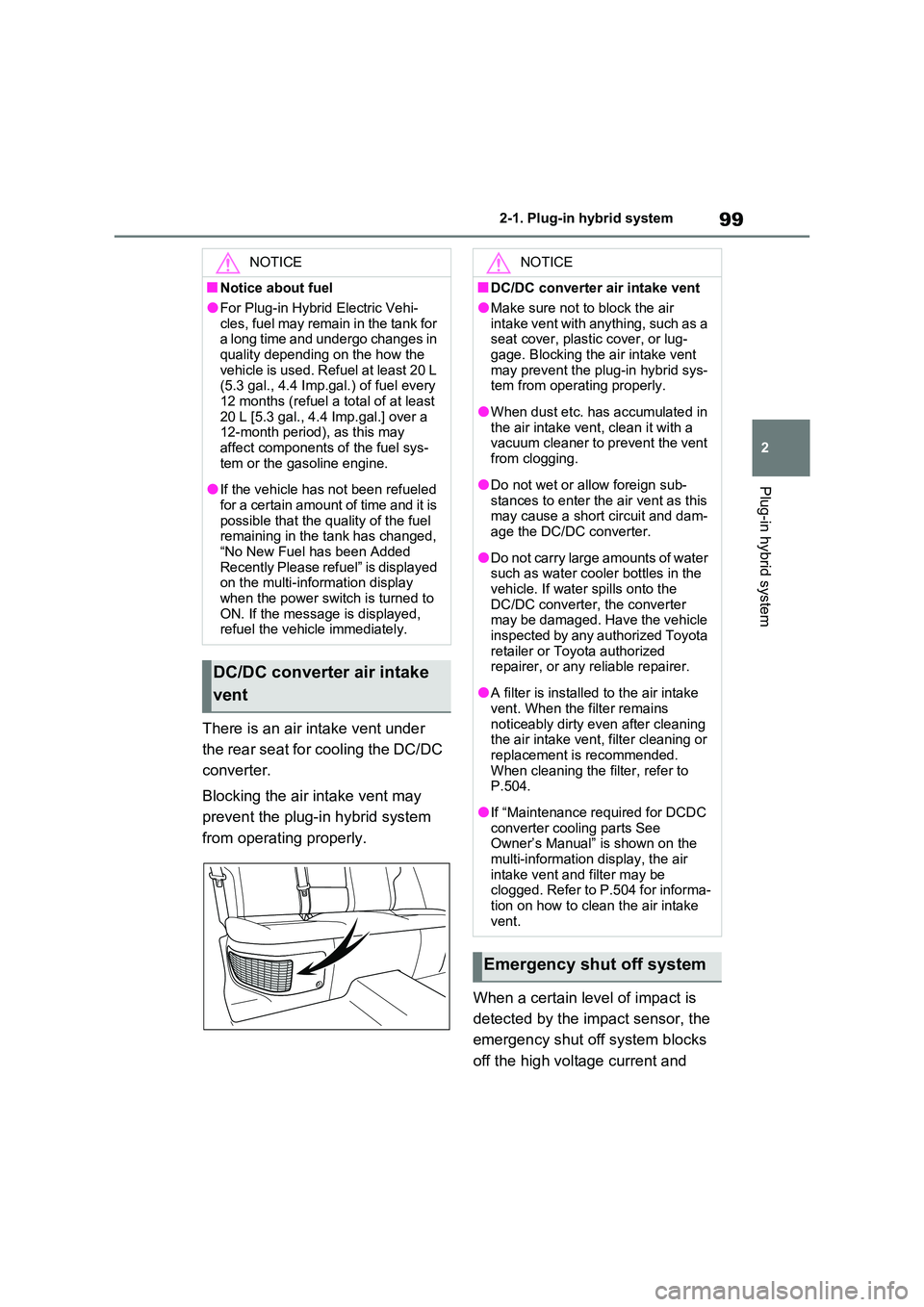
99
2
2-1. Plug-in hybrid system
Plug-in hybrid system
There is an air intake vent under
the rear seat for cooling the DC/DC
converter.
Blocking the air intake vent may
prevent the plug-in hybrid system
from operating properly.
When a certain level of impact is
detected by the impact sensor, the
emergency shut off system blocks
off the high voltage current and
NOTICE
■Notice about fuel
●For Plug-in Hybrid Electric Vehi-
cles, fuel may remain in the tank for a long time and undergo changes in quality depending on the how the
vehicle is used. Refuel at least 20 L (5.3 gal., 4.4 Imp.gal.) of fuel every 12 months (refuel a total of at least
20 L [5.3 gal., 4.4 Imp.gal.] over a 12-month period), as this may affect components of the fuel sys-
tem or the gasoline engine.
●If the vehicle has not been refueled
for a certain amount of time and it is possible that the quality of the fuel remaining in the tank has changed,
“No New Fuel has been Added Recently Please refuel” is displayed on the multi-information display
when the power switch is turned to ON. If the message is displayed, refuel the vehicle immediately.
DC/DC converter air intake
vent
NOTICE
■DC/DC converter air intake vent
●Make sure not to block the air
intake vent with anything, such as a seat cover, plastic cover, or lug-gage. Blocking the air intake vent
may prevent the plug-in hybrid sys- tem from operating properly.
●When dust etc. has accumulated in the air intake vent, clean it with a vacuum cleaner to prevent the vent
from clogging.
●Do not wet or allow foreign sub-
stances to enter the air vent as this may cause a short circuit and dam-age the DC/DC converter.
●Do not carry large amounts of water such as water cooler bottles in the
vehicle. If water spills onto the DC/DC converter, the converter may be damaged. Have the vehicle
inspected by any authorized Toyota retailer or Toyota authorized repairer, or any reliable repairer.
●A filter is installed to the air intake vent. When the filter remains
noticeably dirty even after cleaning the air intake vent, filter cleaning or replacement is recommended.
When cleaning the filter, refer to P.504.
●If “Maintenance required for DCDC converter cooling parts See Owner’s Manual” is shown on the
multi-information display, the air intake vent and filter may be clogged. Refer to P.504 for informa-
tion on how to clean the air intake vent.
Emergency shut off system
Page 102 of 718
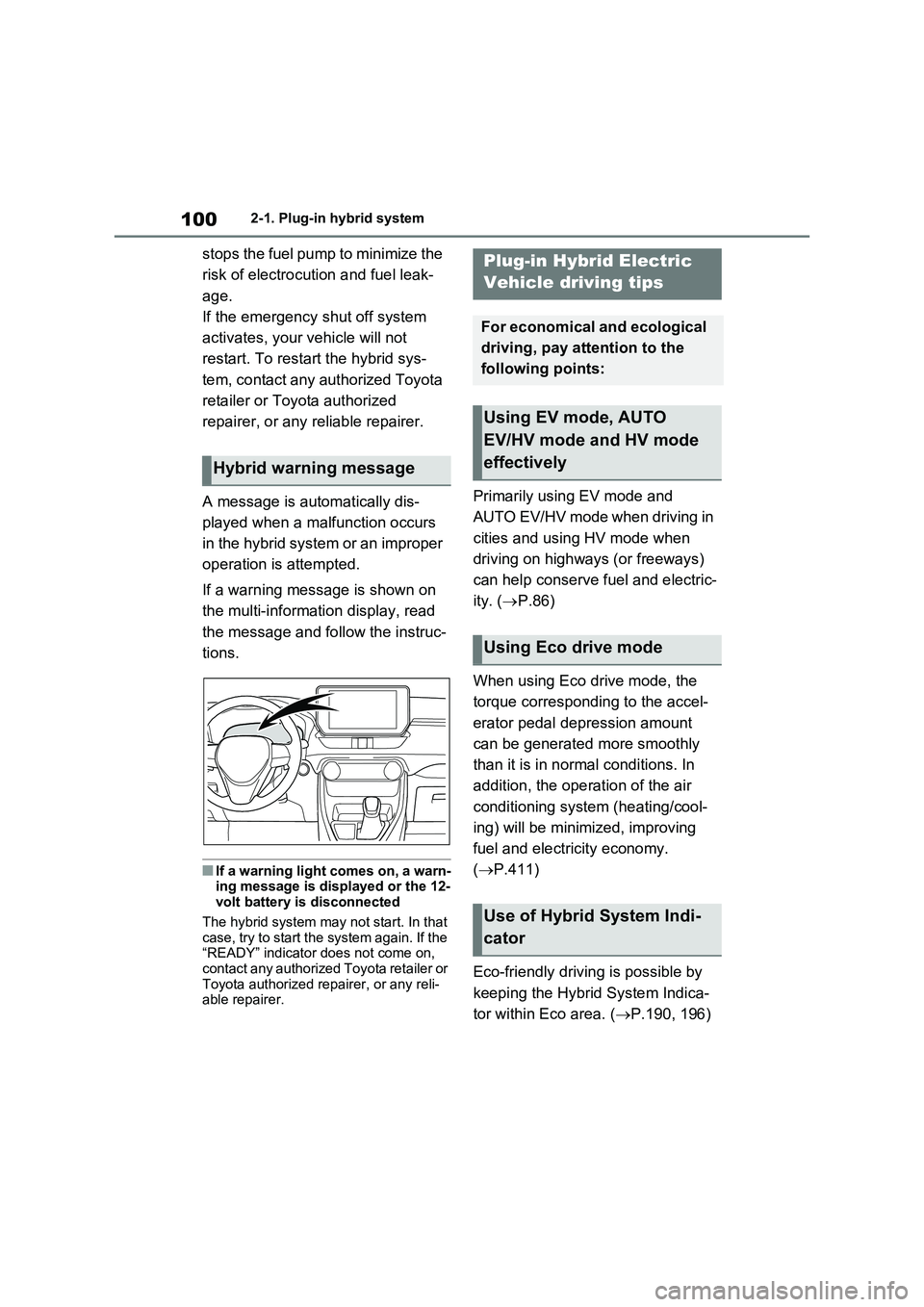
1002-1. Plug-in hybrid system
stops the fuel pump to minimize the
risk of electrocution and fuel leak-
age.
If the emergency shut off system
activates, your vehicle will not
restart. To restart the hybrid sys-
tem, contact any authorized Toyota
retailer or Toyota authorized
repairer, or any reliable repairer.
A message is automatically dis-
played when a malfunction occurs
in the hybrid system or an improper
operation is attempted.
If a warning message is shown on
the multi-information display, read
the message and follow the instruc-
tions.
■If a warning light comes on, a warn-
ing message is displayed or the 12-
volt battery is disconnected
The hybrid system may not start. In that
case, try to start the system again. If the
“READY” indicator does not come on,
contact any authorized Toyota retailer or
Toyota authorized repairer, or any reli-
able repairer.
Primarily using EV mode and
AUTO EV/HV mode when driving in
cities and using HV mode when
driving on highways (or freeways)
can help conserve fuel and electric-
ity. (P.86)
When using Eco drive mode, the
torque corresponding to the accel-
erator pedal depression amount
can be generated more smoothly
than it is in normal conditions. In
addition, the operation of the air
conditioning system (heating/cool-
ing) will be minimized, improving
fuel and electricity economy.
(P.411)
Eco-friendly driving is possible by
keeping the Hybrid System Indica-
tor within Eco area. (P.190, 196)
Hybrid warning message
Plug-in Hybrid Electric
Vehicle driving tips
For economical and ecological
driving, pay attention to the
following points:
Using EV mode, AUTO
EV/HV mode and HV mode
effectively
Using Eco drive mode
Use of Hybrid System Indi-
cator
Page 105 of 718
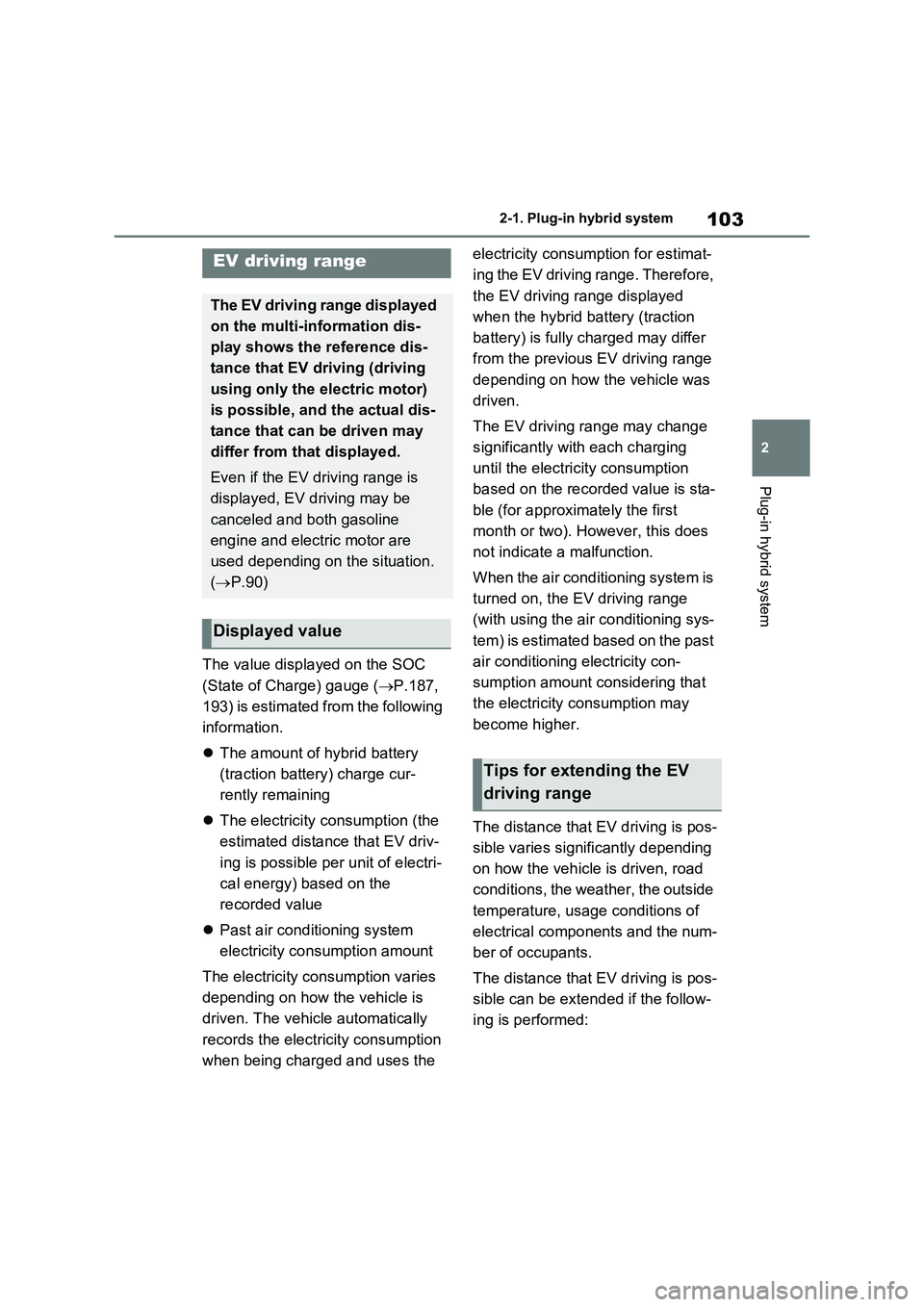
103
2 2-1. Plug-in hybrid system
Plug-in hybrid system
The value displayed on the SOC
(State of Charge) gauge (P.187,
193) is estimated from the following
information.
The amount of hybrid battery
(traction battery) charge cur-
rently remaining
The electricity consumption (the
estimated distance that EV driv-
ing is possible per unit of electri-
cal energy) based on the
recorded value
Past air conditioning system
electricity consumption amount
The electricity consumption varies
depending on how the vehicle is
driven. The vehicle automatically
records the electricity consumption
when being charged and uses the electricity consumption for estimat-
ing the EV driving range. Therefore,
the EV driving range displayed
when the hybrid battery (traction
battery) is fully charged may differ
from the previous EV driving range
depending on how the vehicle was
driven.
The EV driving range may change
significantly with each charging
until the electricity consumption
based on the recorded value is sta-
ble (for approximately the first
month or two). However, this does
not indicate a malfunction.
When the air conditioning system is
turned on, the EV driving range
(with using the air conditioning sys-
tem) is estimated based on the past
air conditioning electricity con-
sumption amount considering that
the electricity consumption may
become higher.
The distance that EV driving is pos-
sible varies significantly depending
on how the vehicle is driven, road
conditions, the weather, the outside
temperature, usage conditions of
electrical components and the num-
ber of occupants.
The distance that EV driving is pos-
sible can be extended if the follow-
ing is performed:
EV driving range
The EV driving range displayed
on the multi-information dis-
play shows the reference dis-
tance that EV driving (driving
using only the electric motor)
is possible, and the actual dis-
tance that can be driven may
differ from that displayed.
Even if the EV driving range is
displayed, EV driving may be
canceled and both gasoline
engine and electric motor are
used depending on the situation.
(P.90)
Displayed value
Tips for extending the EV
driving range